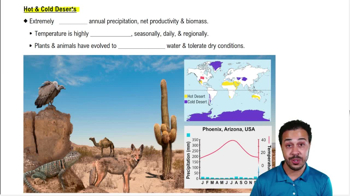- 1. Introduction to Biology2h 40m
- 2. Chemistry3h 40m
- 3. Water1h 26m
- 4. Biomolecules2h 23m
- 5. Cell Components2h 26m
- 6. The Membrane2h 31m
- 7. Energy and Metabolism2h 0m
- 8. Respiration2h 40m
- 9. Photosynthesis2h 49m
- 10. Cell Signaling59m
- 11. Cell Division2h 47m
- 12. Meiosis2h 0m
- 13. Mendelian Genetics4h 41m
- Introduction to Mendel's Experiments7m
- Genotype vs. Phenotype17m
- Punnett Squares13m
- Mendel's Experiments26m
- Mendel's Laws18m
- Monohybrid Crosses16m
- Test Crosses14m
- Dihybrid Crosses20m
- Punnett Square Probability26m
- Incomplete Dominance vs. Codominance20m
- Epistasis7m
- Non-Mendelian Genetics12m
- Pedigrees6m
- Autosomal Inheritance21m
- Sex-Linked Inheritance43m
- X-Inactivation9m
- 14. DNA Synthesis2h 27m
- 15. Gene Expression3h 20m
- 16. Regulation of Expression3h 31m
- Introduction to Regulation of Gene Expression13m
- Prokaryotic Gene Regulation via Operons27m
- The Lac Operon21m
- Glucose's Impact on Lac Operon25m
- The Trp Operon20m
- Review of the Lac Operon & Trp Operon11m
- Introduction to Eukaryotic Gene Regulation9m
- Eukaryotic Chromatin Modifications16m
- Eukaryotic Transcriptional Control22m
- Eukaryotic Post-Transcriptional Regulation28m
- Eukaryotic Post-Translational Regulation13m
- 17. Viruses37m
- 18. Biotechnology2h 58m
- 19. Genomics17m
- 20. Development1h 5m
- 21. Evolution3h 1m
- 22. Evolution of Populations3h 52m
- 23. Speciation1h 37m
- 24. History of Life on Earth2h 6m
- 25. Phylogeny2h 31m
- 26. Prokaryotes4h 59m
- 27. Protists1h 12m
- 28. Plants1h 22m
- 29. Fungi36m
- 30. Overview of Animals34m
- 31. Invertebrates1h 2m
- 32. Vertebrates50m
- 33. Plant Anatomy1h 3m
- 34. Vascular Plant Transport2m
- 35. Soil37m
- 36. Plant Reproduction47m
- 37. Plant Sensation and Response1h 9m
- 38. Animal Form and Function1h 19m
- 39. Digestive System10m
- 40. Circulatory System1h 57m
- 41. Immune System1h 12m
- 42. Osmoregulation and Excretion50m
- 43. Endocrine System4m
- 44. Animal Reproduction2m
- 45. Nervous System55m
- 46. Sensory Systems46m
- 47. Muscle Systems23m
- 48. Ecology3h 11m
- Introduction to Ecology20m
- Biogeography14m
- Earth's Climate Patterns50m
- Introduction to Terrestrial Biomes10m
- Terrestrial Biomes: Near Equator13m
- Terrestrial Biomes: Temperate Regions10m
- Terrestrial Biomes: Northern Regions15m
- Introduction to Aquatic Biomes27m
- Freshwater Aquatic Biomes14m
- Marine Aquatic Biomes13m
- 49. Animal Behavior28m
- 50. Population Ecology3h 41m
- Introduction to Population Ecology28m
- Population Sampling Methods23m
- Life History12m
- Population Demography17m
- Factors Limiting Population Growth14m
- Introduction to Population Growth Models22m
- Linear Population Growth6m
- Exponential Population Growth29m
- Logistic Population Growth32m
- r/K Selection10m
- The Human Population22m
- 51. Community Ecology2h 46m
- Introduction to Community Ecology2m
- Introduction to Community Interactions9m
- Community Interactions: Competition (-/-)38m
- Community Interactions: Exploitation (+/-)23m
- Community Interactions: Mutualism (+/+) & Commensalism (+/0)9m
- Community Structure35m
- Community Dynamics26m
- Geographic Impact on Communities21m
- 52. Ecosystems2h 36m
- 53. Conservation Biology24m
53. Conservation Biology
Conservation Biology
Problem 4c
Textbook Question
Which of the following is characteristic of endemic species? a. They are often found in biodiversity hot spots. b. They are distributed widely in the biosphere. c. They require edges between ecosystems. d. They are often keystone species whose presence helps to structure a community.
 Verified step by step guidance
Verified step by step guidance1
Identify the definition of an endemic species: Endemic species are plants and animals that exist only in one geographic region. Such species can be confined to a particular island, country, or other defined zone.
Analyze option a: Consider if endemic species are often found in biodiversity hot spots, which are regions that are both rich in endemic species and have lost at least 70% of their original habitat.
Analyze option b: Evaluate the statement about endemic species being distributed widely in the biosphere. Recall the definition of endemic species to see if this aligns.
Analyze option c: Consider whether endemic species specifically require edges between ecosystems. Think about the habitats where endemic species are typically found.
Analyze option d: Reflect on the role of keystone species and if being endemic correlates with being a keystone species, which has a disproportionate effect on its environment relative to its abundance.
Recommended similar problem, with video answer:
 Verified Solution
Verified SolutionThis video solution was recommended by our tutors as helpful for the problem above
Video duration:
1mPlay a video:
Was this helpful?
Key Concepts
Here are the essential concepts you must grasp in order to answer the question correctly.
Endemic Species
Endemic species are organisms that are native to and found only within a specific geographic area. This limited distribution often makes them particularly vulnerable to extinction due to habitat loss or environmental changes. They can be found in isolated ecosystems, such as islands or specific mountain ranges, where unique evolutionary processes have occurred.
Recommended video:

Biological Species Concept
Biodiversity Hot Spots
Biodiversity hot spots are regions that are both rich in endemic species and significantly threatened by human activities. These areas are crucial for conservation efforts because they contain a high number of species that are not found anywhere else, making their preservation vital for maintaining global biodiversity.
Recommended video:
Guided course

Hot & Cold Deserts
Keystone Species
Keystone species are organisms that have a disproportionately large impact on their environment relative to their abundance. Their presence or absence can significantly affect the structure and health of an ecosystem. Endemic species can sometimes serve as keystone species, playing critical roles in maintaining the ecological balance within their limited habitats.
Recommended video:

Biological Species Concept

 3:56m
3:56mWatch next
Master Conservation Biology and Biodiversity with a bite sized video explanation from Jason Amores Sumpter
Start learningRelated Videos
Related Practice








































